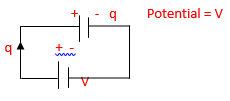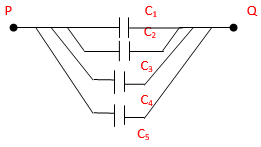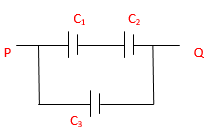Combination of capacitors
Description:
Sometimes it is needed to store more energy within a capacitor or sometimes higher potential difference is required. But a Capacitor can give a fixed value of potential difference and capacitance. So, in order to increase the value of capacitance or potential difference, combination of more than one capacitor is used. There are different designes of combinations and accordingly output is achieved. On the basis of desired output, the combination can be changed.
Two basic combination of capacitors are:
- Series combination
- Parallel combination
Before discussing series and parallel combination, it is important to know the charging and discharging of a capacitor.
Cell
A cell is a charge giving energy source which consist of a positive and a negative terminal and there exists a potential difference between two terminals. Its symbol is shown below:

Battery
The combination of cells forms a battery. Its symbol is shown below:

Charging of capacitor using battery
While charging a capacitor, both the terminals of battery remains connected with the two plates of capacitor as shown in figure:

Electrons from negative terminal of battery are gathered at the plate of the capacitor, with which the terminal is connected and positive terminal of battery pulls electrons from the other plate thereby making the plate positively charged. In this way potential difference is created between the plates and capacitor gets charged. This charging stops as it aquires maximum charges q= CV. Where V is the potential difference of the cell and C = (ε0A)/d.
DisCharging of capacitor
The dielectric or free space between two plates of capacitor do not allow charges to flow from one plate to another. But if both the plates of the capacitor are connected using a conductor , then due to attraction all the electrons from negative charged plate flows to positive charged plate thereby neutralizing all the positive charges. In this way capacitor gets discharged.
Methods of combining capacitors
Method 1
Series connection
Let there be two capavitors (C1 and C2) having capacitance (C1, C2). Capacitor C1 consists of two plates ( say plate A and B) whweras Capacitor C2 consists of two plates ( say plate C and D).
In series combination of capacitor, one plate of a capacitor remains connected with one plate of other capacitor. Let plate B of Capacitor C1 is connected with plate C of Capacitor C2. In between plate A and D a battery is connected so the potential difference is developed at point P and Q. Points are As shown in figure.

If the charge has to move from point P to Q, it has to cross both the capacitors C1 and C2. So in series combination, a charge has to cross all the capacitors connected in series in between the two points. So, If ‘n ‘ number of capacitors are connected in series between two terminals of battery(say P and Q), then, charge will have to cross ‘n’ number of capacitors to move from P to Q.

Method 2
Parallel connection
Let there be two capavitors (C1 and C2). Capacitor C1 consists of two plates ( say plate A and B) whweras Capacitor C2 consists of two plates ( say plate C and D).
In parallel combination of capacitor, both the plates of a capacitor remain connected with the two plates of other capacitor through a conductor and both the plates of all capacitors connected in parallel remains connected with the terminal of battery.
Let plates A and B of Capacitor C1 are connected with plates C and D of Capacitor C2 respectively through a conductor. Let plates A and C are connected to the positive terminal (P) of battery whereas, plates B and D are connected to its negative terminal(Q). As shown in figure.

If the charge has to move from point P to Q, it has to cross either of capacitors C1 or C2. So, a charge gets two paths to move from P to Q. This connection is called parallel connection of capacitor. So, If ‘n ‘number of capacitors are connected in parallel between two terminals of battery(say P and Q), then, charge will have ‘n’ number paths to move from P to Q.

Series parallel combination/ mixed combination
Let there be three capavitors (C1, C2 and C3) having capacitance (C1, C2 and C3). Where C1 and C2 are connected in series and C3 is connected in parallel with C1 and C2. As shown in figure.
If the charge has to move from point P to Q, it has to cross either the series combination of capacitors C1 and C2 or it will have to cross capacitor C3 and move to Q. So, a charge gets two paths to move from P to Q. This is called the mixed combination.

Here C1 or C2 alone is not parallel to C3 but the whole series combination of C1 and C2 is parallel to C3. i.e (C1 + C2 || C3)

